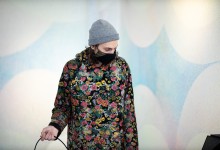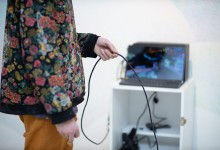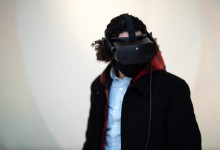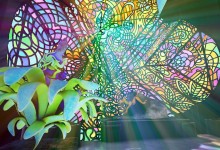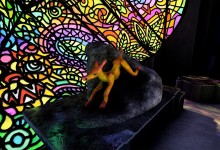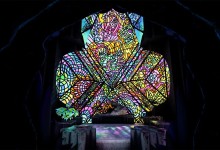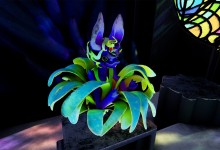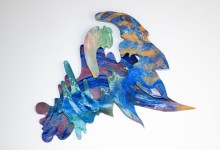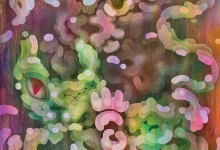Virtual reality exhibition
Sebastian Millar: Vitreus Ombre
Curator: Samuel-Arsenault-Brassard, ELLEPHANT VR artist and curator
Text by Samuel Arsenault-Brassard et Mylène Lachance-Paquin
Virtual and augmented reality is currently transforming the world of visual arts. The advent of Virtual Reality (VR) and Augmented Reality (AR) reminds us of the upheavals that were brought about in the past by the arrival of photography in the visual arts. Indeed, this new approach to artistic inquiry allows artists to explore new ways of interacting with the public by conceptualizing their work according to new paradigms.
Thus, for its 25th anniversary, Art Mûr has chosen to welcome throughout its 2021 programming an artist from these immersive, innovative practices, at the border between the real and the virtual. Samuel Arsenault-Brassard, the curator, has selected some fifteen artists for us.
From February 9 to 27, as part of the group exhibition Terra Nova: A look at the present and the future, Sebastian Millar, also known as Cryote, is fully in line with Art Mûr’s reflexive approach. We are invited to question ourselves on what we leave in heritage, on our relation to the world, to the beings; does all this remain compatible with the future? Through his first creations, Sebastian Millar has developed an imaginary world and an aesthetics of his own. His works, composed of giant and playful animals, feather patterns, furs and bursts of color were painted on canvas or on facades. You can also come across his work in the streets, alleys and stores of Montreal.
At the forefront of new technologies, Cryote has distanced himself from plastic production centered on conventional mediums and has begun to integrate the art of metaverse1 into his work. As a result, the patterns, color planes, cosmic creatures and giant animals he creates have begun to move away from the two-dimensionality associated with analog mediums. To do so, he transformed his apartment and studio into a temporary art gallery. Thus, in 2018 he reopens his gallery LiL Pocket. His first digital art exhibition Illusive Sympathy combined painted woodcuts and Virtual Reality. Then, Sebastian Millar devotes the year 2019-2020 to the study of Virtual Reality, seeking to sharpen his knowledge that would allow him to expand his imaginary world even further. Get ready to dive into his universe which is at the crossroads of realities and mediums. You will discover, under an ethereal light, plants, precious stones and spiritual animals.
From March 2 to 20, it will be Samuel Arsenault-Brassard’s turn to present Flame. A multidisciplinary artist, he has a background in architecture, lighting design and metaverse arts (XR). Arsenault-Brassard is interested in the continuous advances of digital hyper-realities. His works draw their essence through the intersectionality between performance and architecture.
From 2014, while studying at university, Samuel began to develop architectural projects using VR. According to him, the technology would give immense value to digital art. Now the spaces created by artists are no longer just seen from the outside, they can be inhabited, explored and fully felt by visitors. In addition, the architectural world of VR would become a social world from which a new and decentralized form of life would emerge: the metaverse. Even more importantly, the use of these technologies provides artist with a level of power and freedom never fathomed.
In 2016, Samuel Arsenault-Brassard began building VR art galleries that maximized the new freedoms of VR. Flame is part of a long-term VR project titles “Light Gallery”, which consists of roughly 15 rooms for a VR art gallery that will be revealed over the upcoming years. Flame is the second room published from the series and it contains an art piece sculpted in VR throughout 2020. The sculpture in Flame attempts to create a feeling of grandiosity, mystery and sensuality through a complex expressive form and a high level of realism.
While the rooms of “Light Gallery” are digital, each space is crafted to emphasize the “solar” lighting of the external digital world. The goal of these galleries is to provide an ideal environment for art with indirect light encompass it from all sides and angles. Because of the realism of the underlying rendering technology, we can achieve a realistic light and a believable dream.
1. The Metaverse is a collective virtual shared space, created by the convergence of a virtually enhanced physical reality and a physically persistent virtual space, comprising the sum of all virtual worlds, augmented reality and the Internet. The word “metaverse” is a suitcase of the prefix “meta” (meaning beyond) and “universe”; the term is generally used to describe the concept of a future iteration of the Internet, consisting of persistent, shared 3D virtual spaces, linked to a perceived virtual universe.


